Rising Tide: Accelerating Growth of Large-Scale Green Hydrogen Projects Worldwide
Key Ideas
- Currently, there are only two green hydrogen plants globally with electrolyser capacities over 100MW, producing 39 tonnes daily.
- By 2025, the number of such plants is expected to increase significantly, with a potential of 2,800 tonnes per day worldwide.
- China leads in green hydrogen production, boasting the only two operational large-scale green hydrogen plants and surpassing the US in fossil fuel-based hydrogen production.
- China's advancements in green hydrogen technology and infrastructure are paving the way for a cleaner energy future on a global scale.
The global landscape of large-scale low-carbon hydrogen projects is poised for significant growth. Currently, the industry is witnessing a scarcity of success stories in this domain, with only two green hydrogen plants equipped with electrolyser capacities exceeding 100MW operational worldwide. These plants collectively generate nearly 39 tonnes of green hydrogen on a daily basis. However, optimism looms large as projections indicate an eightfold increase in the number of green hydrogen plants surpassing 100MW by the end of 2025. In a best-case scenario, these forthcoming projects have the potential to inject a substantial 2,800 tonnes per day of clean hydrogen into the global market.
A frontrunner in the green hydrogen arena, China has emerged as a trailblazer in advancing both green hydrogen production and infrastructure compared to other nations. Notably, China stands out as the largest producer of fossil fuel-based hydrogen, surpassing the United States with an annual production of 23.7 million tonnes. The two operational large-scale green hydrogen plants globally are both situated within China, underscoring the country's commitment to cleaner energy initiatives. China's strides in green hydrogen technology and infrastructure not only bolster its domestic energy landscape but also set a positive precedent for other nations looking to transition towards sustainable energy practices.
